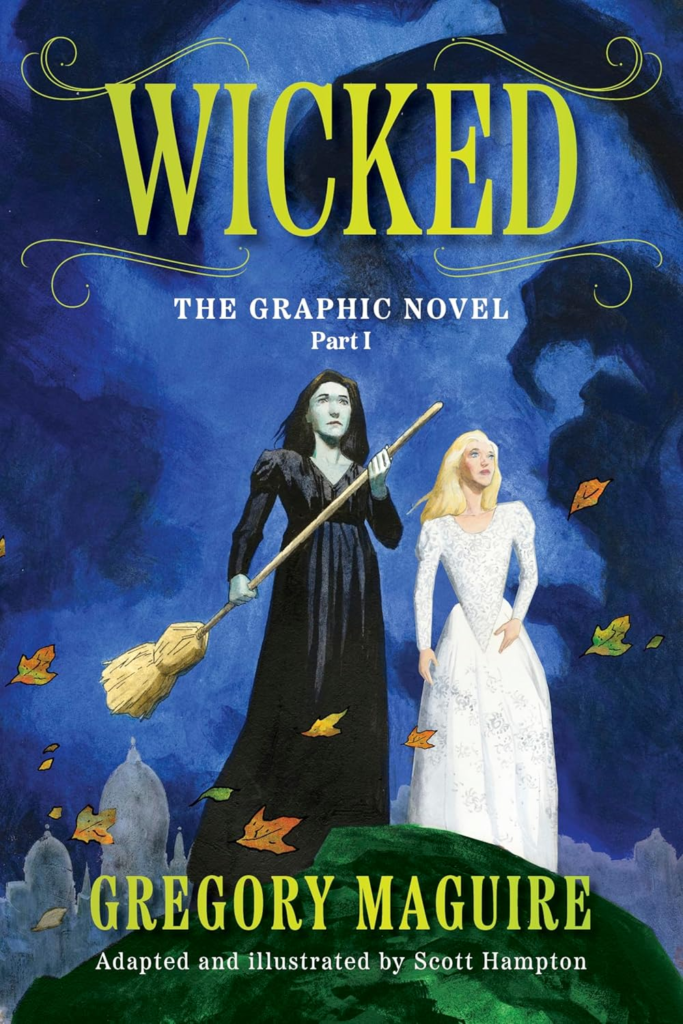I was first introduced to Wicked in 2001, when a friend of mine lent me the novel accompanied by a high recommendation. Since that first time reading the book, I have consumed it in every available medium. I’ve listened to the audiobook, seen the stage musical, and watched the recent film – all at least twice. So the moment I heard a graphic novel was underway, I knew I had to read that too.
The graphic novel is based on the original prose novel by Gregory Maguire rather than the more streamlined plot of the musical. Maguire is even credited as a writer on the graphic novel. That said, artist Scott Hampton is the one responsible for the adaptation, taking on double duty as writer and artist of the comic. Hampton follows Maguire’s original vision fairly closely, taking Elphaba from birth to her schooling at Shiz through her time as a rebel in the Emerald City, and leaving plenty of story for Part 2. It is an excellent introduction to the world of Wicked for those looking to dive into the darker depths of Oz.
The artwork in the book leans toward a painterly, pastel look. One of the most interesting artistic choices is the particular shade of green used for Elphaba’s skin. In the play and films, she is portrayed in a brilliant emerald hue, just like that of original greenie Margaret Hamilton. However, in the graphic novel, she is a much paler shade, so much so that on some pages it becomes easy to forget her otherness. Her lighter tone is even mentioned by Fiyero in the narration. The skin colour matches the overall palette of the book, and makes it clear this is no technicolour dreamscape version of Oz. This is a grim world grappling with political unrest, and the art reflects that conflict.
There is a letterer’s note early to let readers know that when “animals” appears in italics, it “denotes creatures with language and differentiates them from ordinary animals.” This is a key stylistic choice as the main conflict of the story centres on Elphaba’s fight for Animal rights. Her time at Shiz university, which takes up the bulk of the graphic novel, is mainly dedicated to scientifically proving that Animals are biologically the same as humans. What is interesting about the italics is that unlike the book – which uses the capital letter “Animal” – specific Animals are never named. For instance, in the book Dr. Dillamond is noted as being a Goat, but in the graphic novel, he is never called a “goat“. This changes the language around Animals, grouping them all together as one rather than distinguishing races, making their plight feel more universal. The goats, bears, lions, etc of Oz all are animals, and all are suffering. Elphaba, with her green skin, looks almost like an Animal herself in the graphic novel and so her empathy for their plight becomes all the more appropriate.
Speaking of the lettering, there is a lot of text included in the graphic novel, much of it taken directly from Maguire. Hampton does an excellent job weaving the prose into the comic, enhancing his art with Maguire’s words. He also follows Maguire’s lead by letting other characters act as the narrator for different sections, such as Boq at Shiz and Fiyero in Emerald City. Like the book, this makes Elphaba herself a more elusive and mysterious character, always at the centre of our attention but never revealing her inner self.
Overall, the graphic novel is an excellent adaptation that any Wicked novel fan will enjoy. I would, however, hesitate to recommend it to anyone unfamiliar with the book’s darker tone when compared to the musical. The book and graphic novel are both a much more grim story, with adult themes around politics and racism, and several violent/sexual scenes that are not for children. But the adaptation stands on its own as an exploration of what it means to be moral vs. good.
Pre-order Wicked Part 1 (Graphic Novel) from Forbidden Planet and Waterstones. Wicked Part 2 (Graphic Novel) coming March 2026 in the UK!

